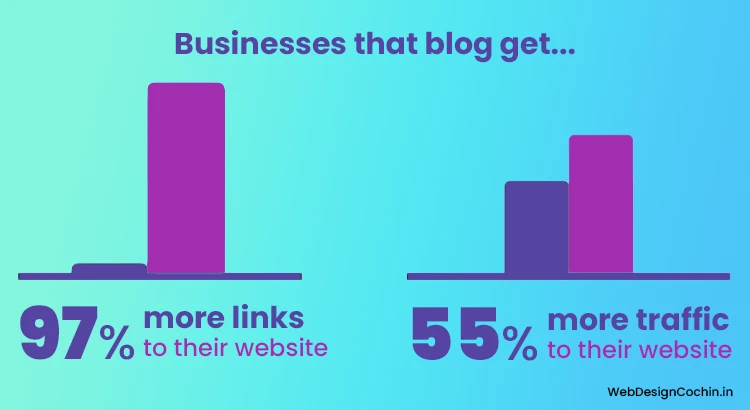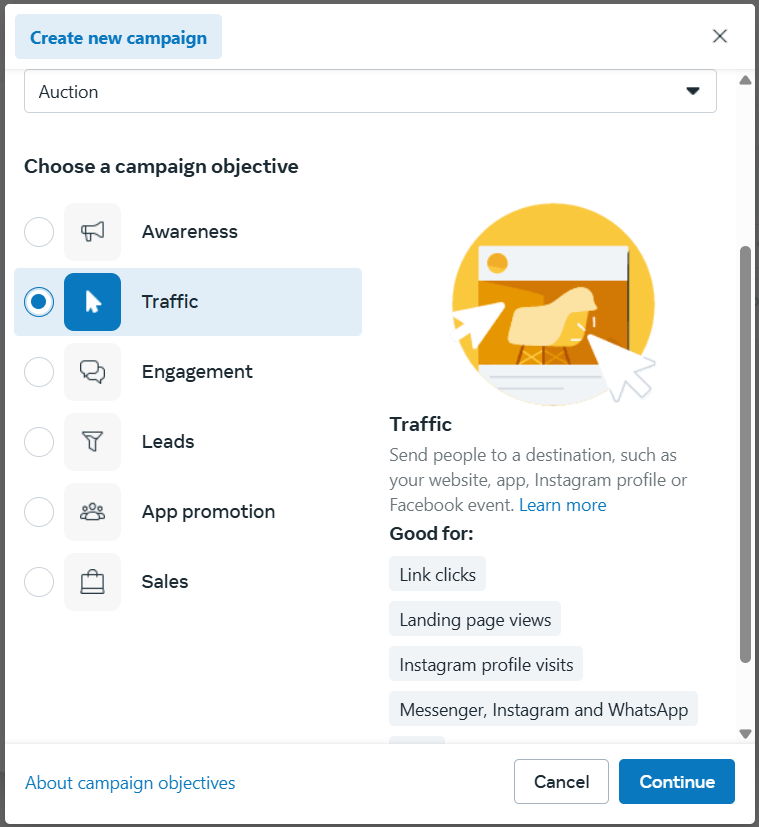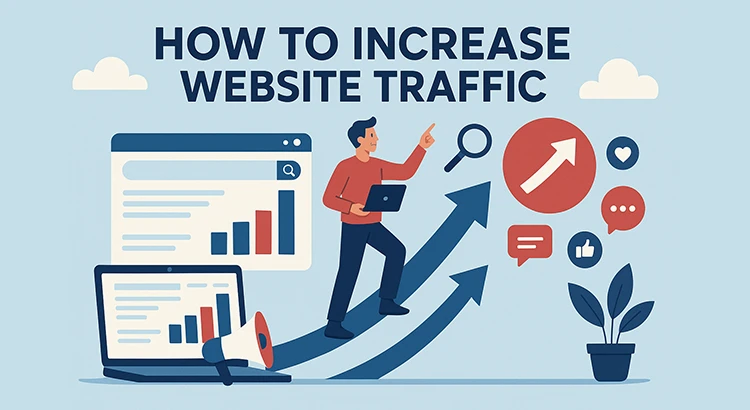Every business with an online presence eventually needs to figure out how to increase website traffic to grow and succeed. Whether it’s a new blog, an ecommerce store, or a service-based site, bringing in more visitors is often the first step toward higher conversions and brand visibility. In fact, many marketers consider traffic generation one of their biggest ongoing challenges.
There are plenty of effective ways to boost website traffic, and this article breaks down 39 of them. These methods cover content creation, optimization, social media, business listings, and helpful tools to support steady and long-term growth.
Table of Contents
- How to Drive Traffic to Your Website with Content
- How to Increase Traffic to Your Website With SEO
- How to Increase Traffic to Your Website Using Social Media
- How to Get Traffic to Your Website with Listings
- More Ways to Increase Website Traffic
- Tools to Boost Traffic to Your Website
39 Ways to Improve Traffic to Your Website
Increasing website traffic requires a mix of creativity, consistency, and the right techniques. There is no single solution that works for everyone, but combining several proven methods can lead to impressive results.
The methods given below will help you increase traffic to your website through a variety of effective techniques and strategies. These have been grouped by category to make it easier to focus on what fits your goals and resources best.
How to Drive Traffic to Your Website with Content
To drive traffic to your website, you must have high-quality content. Without it, even the best strategies will fall short. While you might be tempted to skip over this section, it’s essential to remember that content serves as the backbone of all other methods. Quality material not only attracts visitors but keeps them coming back for more.
1. Start a Business Blog
One of the most effective ways to drive traffic to your website is by starting a blog. Regularly publishing valuable, long-form content not only attracts visitors but also boosts your website’s SEO. Having a blog is crucial for any business that wants to grow its online presence.
Consider these statistics:
- Companies that maintain a blog receive 97% more backlinks to their site.
- Businesses with blogs see 55% more website visitors compared to those without.
- Marketers with blogs are 13 times more likely to experience a positive return on investment (ROI).

By providing useful material, you give people more reasons to visit your site and engage with your brand. Without a blog, many of the other strategies in this article will be much harder to implement effectively.
2. Focus On Evergreen Topics
While news and trending topics can give you a short-term website traffic boost, they often don’t provide long-lasting value. Instead, focus on content that will remain relevant to your audience over time. Evergreen content consistently attracts visitors and accumulates backlinks, especially if you periodically update it to keep it current.
3. Write Irresistible Headlines
Headlines are essential for driving traffic to your content. Studies show that well-crafted headlines can boost website traffic by as much as 500%. Without a compelling headline, even the most valuable material may go unnoticed. Learning how to write attention-grabbing headlines will ensure your posts get clicked on in search results.
4. Invite Others to Guest Blog on Your Site
Guest blogging allows you to bring fresh perspectives and diverse voices to your site. Moreover, guest authors are likely to share their posts with their audience and link back to your site, helping you gain new visitors. Just ensure the content is high-quality and original, avoiding any spammy links that could negatively impact your search engine ranking. Establishing clear guest posting guidelines will keep the content aligned with your brand and avoid any potential issues.
5. Create Awesome Visuals
Use design tools like Canva to create engaging visuals that help explain concepts, present data, or display charts aligned with your branding. When other websites share your images, they will link back to your site, improving your visibility. Additionally, Google is showing more images in regular search results, offering more opportunities for your site to rank higher and increasing the likelihood that users will click on your material.
6. Incorporate Video
While text-based content remains valuable, video has the power to attract more visitors and keep them engaged for longer periods. Consider these ways to leverage video for increasing website traffic:
- Embed videos into your blog posts to boost visibility in video search results.
- Optimize your YouTube videos for search so they rank higher and include links to your website in the video description.
- Add call-to-action buttons directly within the video to direct viewers to your site.
7. Have A Resource Center
Your content strategy should go beyond blogs and videos to include a variety of formats such as infographics, downloadable guides, templates, and webinars. To maximize the value of these resources, gather them in one place on a resource center page. A well-organized library of educational content is sure to attract regular visitors and establish your site as a trusted source of useful materials.
How to Increase Traffic to Your Website With SEO
There’s one important detail about all the content-focused techniques mentioned earlier. None of them will work well if people can’t actually find your site. Since the first page of Google captures the majority of search traffic clicks, a strong search engine optimization plan is essential.
Search engine optimization helps make your pages more visible for relevant search queries. While it can be an in-depth process, starting with the basics can already make a big difference.
8. Target Keywords
Keywords are the terms people enter into search engines when they are looking for something. Some are searched more frequently than others. For example, the phrase “how to increase website engagement” might only bring in a handful of monthly searches, while “how to increase website traffic” attracts hundreds. Understanding keyword demand helps you focus on terms with higher potential to bring visitors.
9. Use Long-Tail Keywords
It might seem logical to go after the highest-volume keywords, but they are often too broad and very competitive. A keyword like “website” might have huge volume, but it’s not specific enough to attract the right audience. Long-tail keywords are more focused, easier to rank for, and tend to bring in visitors who are more likely to engage with your content.
10. Place Your Keywords Strategically
Once you have selected your target keywords, make sure to use them in key areas of your content. This helps search engines understand the topic of the page and match it with relevant queries. Include your keywords in:
- The title tag
- The main H1 heading
- At least two H2 subheadings
- The first 100 words of your content
- Naturally throughout the body text
- Image file names and alt text
- The meta description
11. Optimize Your SERP Appearance
Including keywords in your meta title and meta description is just the beginning. To truly improve visibility and attract more organic clicks, these elements need to be engaging and well-structured.
- Meta description: Keep this between 155 and 165 characters. Clearly highlight the value readers will get and make the copy action-focused.
- Meta title: Limit to 60 characters or less, place the keyword near the beginning, and emphasize the benefit or value of the page.
12. Link Internally
Every time you publish content, include one to three internal links to other relevant pages on your site. This not only drives traffic across your pages but also increases session duration, improves page views per visit, and enhances user experience. These actions signal quality to search engines and help improve visibility in search results.
13. Improve Your Page Speed
If a site takes too long to load, most visitors will leave before seeing anything. Fast-loading pages reduce bounce rates and improve rankings. Speed has long been a factor in search performance, and it carries even more weight with the current page experience standards.
Optimize elements like image sizes, layout structure, and third-party plugin usage. Tools like Google’s PageSpeed Insights provide performance scores and recommendations for improving Core Web Vitals and overall load time. Aim for smooth, quick-loading pages to retain and attract more website traffic.
14. Make Your Site Responsive
A significant portion of online traffic now comes from mobile devices. If users need to pinch and scroll just to navigate your pages, they are likely to leave. Even a simple website must be fully accessible and easy to view on all screen sizes, including smaller smartphones and tablets.
15. Implement Schema Markup
Using schema markup or other structured data formats can help search engines better understand and index your pages. While it might not increase website traffic directly, it improves your site’s visibility by enhancing your appearance in search results with rich snippets. This can lead to a higher click-through rate and more visitors over time.
16. Regularly Refresh Your Content
Even content that is considered evergreen can become outdated. Content freshness plays a role in search visibility, and updating your articles can improve rankings and attract more clicks. A refreshed publish date on the search results page often leads to improved click-through rates and more website traffic.
However, updates need to be meaningful. Simply changing a few words and updating the date is not enough. Consider the following steps when refreshing a post:
- Update or include new statistics and information.
- Replace old visuals or add new graphics to enhance understanding.
- Add links to current, relevant resources.
- Fix any broken links or images.
- Include new keywords based on your search query data.
- Revise your meta title and meta description to match updated content.
17. Get Backlinks
One of the strongest factors influencing search engine rankings is the number and quality of backlinks pointing to your website. Links from reputable websites with high Domain Authority can significantly boost your own authority. As your Domain Authority increases, so does your visibility in search results, bringing more organic visitors. Additionally, backlinks can generate referral traffic from the linking sites.
There are many effective approaches to building backlinks. Here are a few to consider:
- Reach out to reputable websites and offer to contribute a guest post that includes a link to your site.
- Use website optimization tools to find broken links on relevant sites and suggest your content as a suitable replacement.
- Publish original, valuable content that naturally encourages others to link to it.
How to Increase Traffic to Your Website Using Social Media
Social media marketing offers numerous benefits, one of the most significant being the potential for referral traffic to your website. By leveraging the right platforms effectively, you can turn social media into a powerful traffic generator for your site. Here’s how you can make it work for you.
18. Promote Your Content on Social Platforms
Publishing valuable content is only the first step. You also need to share it where your audience spends time. Whether it’s short updates on Twitter, visual posts on Instagram and Pinterest, or articles on LinkedIn, every channel offers an opportunity to drive visitors to your site. If your business has a physical location, posting on Google Business can also boost local visibility. The more people see your content, the greater your chances of attracting new visitors and earning valuable links.
19. Add Relevant Hashtags
When posting on platforms like Instagram, Twitter, and LinkedIn, use hashtags to expand your reach. Choose hashtags that closely match your topic so that your posts appear in front of the right audience. This improves the chances of attracting users who are genuinely interested in your content and more likely to engage, share, or link to it.
20. Create Content for Amplifiers
Rather than only focusing on your customers, also consider the people and platforms that can amplify your content. These amplifiers may include:
- Popular industry sites such as trade magazines, online news platforms, and top blogs
- Influential journalists and creators who speak to broader audiences
- Loyal customers who regularly share or recommend your brand
- Users with strong networks or readers who trust their recommendations
21. Post Native LinkedIn Articles
LinkedIn is more than just a networking site. It’s also a powerful content platform. Publishing thoughtful content on LinkedIn can increase your site traffic, bring more visibility to your company page, and position you as a professional voice in your industry. You don’t need to create something brand new every time. Repurpose existing content or reflect on recent industry trends to stay active.
22. Interview Industry Thought Leaders
You don’t need to be a major publication to land interviews with key figures. Many industry professionals are open to interviews if approached respectfully. Feature these conversations on your blog to boost credibility, bring in more visitors, and benefit from shares by the interviewees themselves.
23. Add Social Share Buttons
Make it easy for visitors to share your content. Include social share buttons on your blog posts and resource pages so users can post to their networks in just a few clicks. You can also include a one-click Tweet option with prewritten text to encourage even more sharing. These small additions can lead to big traffic gains.
24. Research The Competition
Keeping an eye on your competitors can give you valuable insight into what content performs well in your industry. Look at which topics are getting the most attention and engagement on social media, blogs, and other platforms. Identify common themes, formats, and headlines that resonate with the audience. Then, use those findings to create your own high-quality content that appeals to similar interests and drives traffic to your website.
25. Post At the Right Time
Timing matters when it comes to social sharing. Check your social media analytics to find the best times your audience is most active. Start with general benchmarks, then adjust based on your specific data. Sharing content when engagement is highest can significantly boost visibility and website traffic.
How to Get Traffic to Your Website with Listings
Online directories can be a solid source of referral traffic, but simply adding your business is not enough. To maximize visibility and clicks, you need to fully optimize your listings.
Start with your Google Business Profile. A well-optimized listing can help you show up in Google Maps and Search results. Facebook is also key, acting as a major directory in its own right. Others like Yelp, Angie’s List, and industry-specific platforms also help expand your reach.
To get the most from your listings:
- Fill out every available section.
- Choose the right business category.
- Keep your name, address, and phone number consistent across all platforms.
- Encourage customer reviews and respond to them.
- Upload quality photos.
- Update your information regularly.
More Ways to Increase Website Traffic
To increase website traffic, you need to employ a combination of strategies that can engage your audience, build your online presence, and drive more visitors to your site. Here are some additional methods to boost your website traffic:
26. Host Webinars
Webinars are a fantastic way to share your expertise with an engaged audience. When paired with a solid promotion plan on social media and via email, they can be a powerful traffic driver. Be sure to send a reminder email about a week before the event and a “last chance to register” email the day before. Afterward, archive the webinar for future viewing and continue to promote it on your social channels to keep traffic flowing to your site.
27. Optimize Your Listings
Ensuring your business listings are optimized is essential for local SEO and attracting more visitors. Fill out all sections of your listings, including categories and accurate contact details. Keep information consistent across platforms, encourage reviews, and make sure to add quality images. An up-to-date and fully optimized listing can help boost your visibility and drive more traffic to your site.
28. Start an Online Community
Creating a space where your audience can engage, share their thoughts, and discuss topics they care about can significantly increase website traffic. Implement a commenting system or even a forum to allow users to ask questions and exchange ideas. It’s essential to moderate your community to ensure meaningful and respectful interactions, which will keep visitors coming back to your site.
29. Participate in Forums
Engaging in online forums and social media groups like LinkedIn, Facebook, and Reddit is an effective way to share your knowledge and build brand awareness. While promoting your website can be tempting, only share links when it’s relevant and allowed. Avoid posting links in every comment. Instead, focus on contributing value and engaging with users. People interested in your insights will likely visit your site on their own or find it through your profile.
30. Attend Conferences
Conferences and industry events offer valuable opportunities to connect with peers, potential clients, and thought leaders. Attending these events allows you to network, while speaking at them can position you as an authority in your field. Even a modest speaking engagement can drive exposure to your site and significantly boost traffic by showcasing your expertise.
31. Submit Your Content to Aggregator Sites
Many blogs and websites use RSS feeds to display content from various sources. Aggregator sites allow users to follow their favorite blogs and receive updates via email. While most aggregator sites will automatically find your RSS feed, consider submitting your content to paid aggregators for additional exposure. This can help attract more visitors to your site by placing your content in front of a broader audience.
32. Start an Email Newsletter
A newsletter doesn’t have to be complex. Simply curate and share your most recent content or highlight topics that your audience might not actively search for. For example, articles on niche subjects can do exceptionally well when sent directly to your email list. Just be careful not to overwhelm your readers with too many emails or an excessive number of links in one message.
33. Reach Out to Email Newsletters
There are countless email newsletters tailored to specific topics, and many of them accept guest contributions or content pitches. Research newsletters within your niche and offer valuable content. Getting featured can drive a significant traffic spike, while also attracting potential regular readers or new newsletter subscribers.
34. Create a Free Tool
What’s better than free content? Free and useful tools. Whether it’s an idea generator, an assessment, a quiz, or a calculator, providing a helpful tool on your site can drive substantial traffic. Optimize the landing page with long-form content, and your tool could rank organically in search results. Make it something that visitors can use repeatedly to keep them returning to your site.
35. Advertise
While SEO is highly effective, it can take several months of consistent effort to start seeing significant results. In the meantime, investing in paid advertising can quickly boost your site traffic. Search, display, and social ads are all great ways to target specific audiences and drive more visitors to your site.
Each advertising channel has its strengths and weaknesses, so it’s important to align your goals with the right strategy. Google Ads, for example, can help you attract targeted visitors. When using paid search, consider focusing on high commercial intent keywords to maximize the chances of converting traffic into sales. Although competition for these keywords can be fierce and costly, the return on investment can be substantial.

Tools to Boost Traffic to Your Website
There are various tools available that can help you increase your website traffic, from analyzing performance to enhancing your material. Here are some effective options to consider.
36. Track SEO Metrics in Google Analytics
Google Analytics offers a treasure trove of data, providing insights into your most popular pages, visitor demographics, and more. Regularly monitor your SEO metrics to better understand how your site is performing. Use this data to refine your content strategy, promotional efforts, and identify which traffic sources are most effective. By focusing on what’s working and scaling up those efforts, you can enhance your overall website traffic.
37. View Your Queries in Google Search Console
Google Search Console is an invaluable tool for identifying the search queries that drive traffic to your site. By analyzing this data, you can ensure your pages are ranking for the right keywords, discover new ones to target, and optimize existing material. Additionally, you can review your site’s organic click-through rates and resolve any indexing issues, which can ultimately enhance your site’s visibility and traffic.
38. Analyze the SERP with SEO Tools
SEO tools, such as Semrush and Ahrefs, are essential for in-depth analysis of search engine results pages (SERP). They provide insights into keyword research, backlink analysis, content gaps, and ranking opportunities. These tools also allow you to audit your site and evaluate your competitors’ pages, helping you refine your strategy to improve your traffic and rankings.
39. Audit Your Site with Website Graders
Website graders are simpler, user-friendly tools that provide actionable insights to improve your site’s SEO. These tools audit various aspects of your website, such as accessibility and content readability, and offer easy-to-understand reports with recommendations to enhance your site’s performance. While not as comprehensive as all-in-one SEO tools, they are great for identifying quick wins and improving overall site quality.
Wrapping Up
Learning how to increase website traffic involves a combination of strategies that work together to build sustainable growth. By consistently applying these methods, experimenting with different approaches, and deeply understanding your audience, you can drive long-term results. Whether you’re just getting started or aiming to scale, the key to success lies in ongoing optimization and adaptability.


